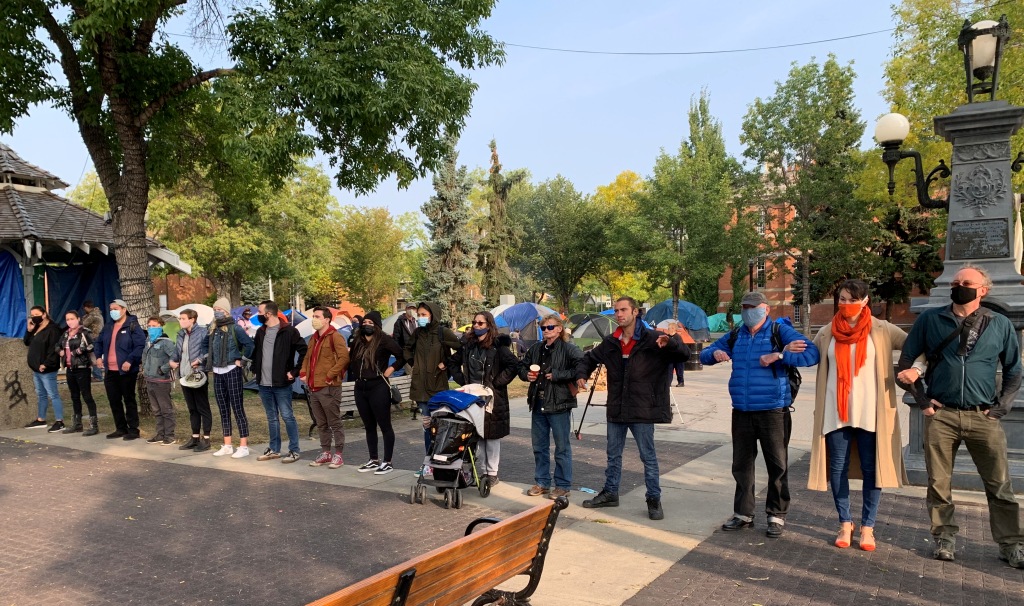Old Strathcona Peace Camp Raises Awareness of Edmonton’s Unhoused
Posted on September 21, 2020 By Paula E. Kirman culture, Front Slider, Life, News
 Camps set up by members of Edmonton’s “unhoused” population are a familiar sight in the inner city and River Valley. More and larger encampments are appearing, a visible testament to a lack of safe, affordable shelter and supports.
Camps set up by members of Edmonton’s “unhoused” population are a familiar sight in the inner city and River Valley. More and larger encampments are appearing, a visible testament to a lack of safe, affordable shelter and supports.
The latest such community is the Peace Camp, a group of about 20 tents that set up in Dr. Wilbert McIntyre (Gabezo) Park just north of Whyte Avenue, on Sept. 5. At first the site was made up of unhoused youth, many of whom are indigenous and had aged out of the foster care system. The group came together out of frustration after camping in the Mill Creek Ravine area, and experiencing their tents slashed and property taken.
After just a few days unhoused people from other age groups joined the Peace Camp. Donations of food, clothing, and other supplies have been keeping the residents fed and warm, while volunteers have been helping with essentials such as food service and medical assistance. A fire was lit in a portable fire pit. A community was created.
“There has been a tremendous outpouring of support from all across the city. People from all walks of life have provided food, money, water, tents, sleeping bags, blankets, everything we’ve needed. Even without any kind of organization or charitable structure, we’ve been able to adequately meet the needs of the people in the camp,” says community activist and volunteer Johnny Blackburn.
 He says that the camp is much safer than most of the alternatives available. In fact it has lived up to its name of being a peace camp, and has been providing assistance to anyone, even if they’re not staying there.
He says that the camp is much safer than most of the alternatives available. In fact it has lived up to its name of being a peace camp, and has been providing assistance to anyone, even if they’re not staying there.
“There was an attack on someone outside the camp involving a machete. The victim came to the camp to get help,” Blackburn says. “There was a first aid responder with a well-stocked first aid kit who was able to stop the bleeding and get the victim to hospital. If that person was in a ravine somewhere, they might not have made it.”
On Wednesday, Sept. 16, the Peace Camp was served with an eviction notice from the City, demanding that the camp be cleared by 10 a.m. on Friday: All tents and structures were to be removed, and the fire to be extinguished. When the deadline rolled around, campers and supporters stood in a line around the south side of the park, awaiting the police and bylaw officers. The fire kept burning.
Two members of EPS arrived. Cameron Noyes, a longtime local activist and spokesperson for the camp, explained in front of media that people at the camp were being clothed and fed, they were in a safe place, and that no one should be forced out without having secured housing arrangements. Negotiations continued in private. Meanwhile, housing intake was on site, and in the last week about a dozen people were able to be placed in homes. Later on Friday afternoon an unofficial one-week extension was announced – buying the camp a few extra days.
“Right now we just want to get people housed,” says Noyes, who says he is awaiting a written notice from the city that they are going to bring down housing workers. Once that letter is received, the camp has seven days.
“There are a few other things we need to address, like how First Nations are over-represented in the foster care and prison systems,” Noyes adds. “Also, we really want safe supply and safe injection sites. We realize this is a marathon, not a sprint, and these things will take a while. But our immediate thing is housing.”
The Peace Camp is not affiliated with Pekiwewin – a camp that was established on green space in the Rossdale area across from RE/MAX Field in July. It is meant to be a relief and prayer camp against police violence, with an organizing team led by people who are indigenous, woman-femme, and 2-Spirit.
The very fact that encampments like these exist demonstrate the failure of the city and province to solve the issue of houselessness. Certainly the powers-that-be must realize that the solution is (wait for it): housing. There are nuanced complexities. Housing doesn’t simply mean putting people in shelters, which are often full, require putting up with religious components, or have other requirements that make it impossible for many unhoused folks to be there (such as no spouses, no pets, having to be clean and sober).
Some of the unhoused people in the Peace Camp say they are there because they want to stay near the Whyte Avenue area, and not be moved to the inner city, where they are trying to avoid an area over-saturated in agencies, shelters, and resulting social problems. One Peace Camp resident (who did not want to be named) said that they did not want to relocate downtown due to concerns of violence.
The solution: systemic changes that view an unhoused person holistically by taking a person’s overall state of being into consideration. Issues often include intergenerational trauma, a factor in someone being part of the foster care and-or criminalization system. Addictions (often also the result of trauma), mental health issues (again exacerbated or caused by prolonged trauma), and physical disability also factor in the equation. Our health care system, which has been constantly under attack by the current provincial government, is not adequately meeting mental health needs, and threats of further cuts to AISH put already economically-marginalized people with disabilities at further risk.
If camps for the houseless are considered unacceptable by those in power, then they need to do the work to fix a broken system that benefits landlords more than tenants, and which allows people experiencing addiction and mental health to slip through the cracks. Winter is coming, and despite promises of ending houselessness by certain arbitrary deadlines, it looks like the city is going to leave a number of its citizens out in the cold – again.
NOTE: The terms “unhoused” and “houselessness” are preferable to “homeless” and “homelessness.” Not living in a house and not having a home don’t necessarily equate. Some homes are indoors; some are outdoors.
Top photo: Campers, supporters, and volunteers link arms to form a barrier in case EPS started dismantling the camp by the Friday deadline. Second from right (orange scarf) is Heather McPherson, MP for Old Strathcona.













